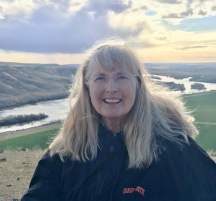No products in the cart.
A Curling Brew

Life on the Snake
By Diana Hooley
I’ve lived on the Snake River all my adult life and have grown to love this curling brew of Teton Range snowmelt. When I married an Idaho farmer and first came to live here from the East, I was surprised at the blue color of the river. The rivers in the Midwest, where I grew up, tend to run a murky grey.
The Snake can look as blue-blooded as royalty, and it truly is one of Idaho’s crowning assets. It’s not only a wonderful wildlife refuge and recreation area but it also produces hydroelectric power and fuels our lucrative agricultural industry.
When we first built our home, I wanted to plant my garden on the banks of the Snake. Living on a farm, I had multiple places to plant a garden, but the riverbank was a good choice. When I’m sweaty and need a break from hoeing and weeding around my tomatoes and cucumbers, I look out over the river.
It takes only a few moments of standing and leaning on my hoe to feel rested. I find myself staring at a cormorant diving for a fish or deer swimming across to the island. Just watching the river’s undulating current is relaxing.
We bought our farm over forty years ago from an old farmer named Dave. There’s a picture somewhere in my house, stored in a box, of a young Dave in the 1950s. He’s standing near the river’s edge wearing coveralls, a ragged cap pulled forward to shade his eyes.
Next to him is a sturgeon hanging from a hook. The fish is bigger than Dave. It looks more than six feet long and probably weighs a couple hundred pounds. Dave caught the fish in one of several sturgeon “holes” that dot the Snake River.
“Do you ever swim in the river?” a friend from Boise recently asked
when he visited our farm.
I gazed at our friend, trying to formulate a simple answer, but swimming in the Snake is complicated. “Oh yes, when my children were little, after the water level dropped in July. We fenced the cows off a sandbar. We liked to swim there, because an island across the way broke the current.”
Most rivers are inherently dangerous because of their current—but especially in Idaho, the whitewater state. Rivers here fall quickly and steeply from our high mountains. The Salmon, the Payette, and the Lochsa have world-renowned Class IV and V rapids.
I’ve canoed through a few whitewater ripples on the Snake just upriver from our house. Rocks jut out in a line near the middle, creating a rapids effect. In the summer dozens of pelicans fish off those rocks.
Though this Snake has a bite, I’m still attached to the river, and not just because of its power and beauty.
As farmers, my husband and I are dependent on the Snake to irrigate our peppermint and alfalfa fields. We’re currently trying to decide where to locate a new pumping station and lay pipes.
Like many farmers across Idaho, we’re replacing open-ditch irrigation canals with buried pipelines. Open ditches are hard to maintain and to keep clear of weeds and moss. They also lose water to ground seepage and are generally less efficient.
“You can put the new pumping station anywhere—but there,” I pointed toward the riverbank behind our house. “I don’t want to hear the whine of irrigation pumps when I sit on the patio.”
Occasionally, I’ll dream about the Snake River. In my dreams the river is never identified. It’s just a body of water moving past me and on into the canyon. Sometimes I’m in a house on a high bluff looking down at the river. I can see clouds and trees reflected on its surface.
People wave at me from boats and inner tubes as they flow past. In those dreams I don’t feel much of anything. I’m not happy or sad or frightened. I just feel calm, as if all was right with my world.
This content is available for purchase. Please select from available options.
Register & Purchase Purchase Only
Register & Purchase Purchase Only

